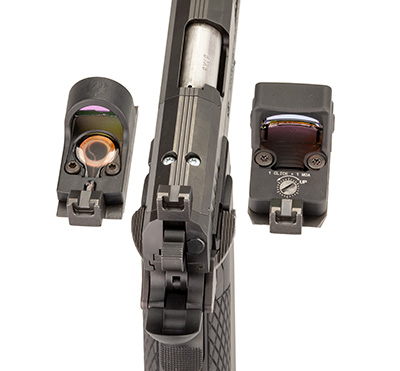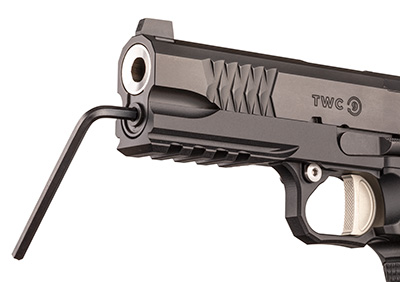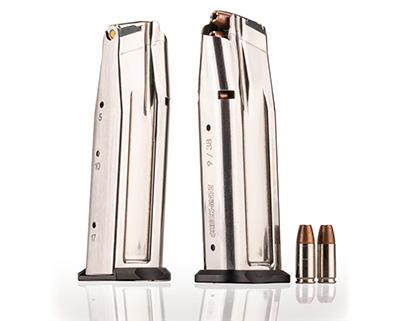
While not a new phenomenon, semi-automatics based on the traditionally single-stack M1911 platform but instead built around a double-stack frame have, until recently, been a specialized niche produced by a small number of manufacturers. These widebody, “2011-type” pistols have gone mainstream during the past few years, however, with seemingly every maker of M1911s expanding its catalog to include higher-capacity options, many of which are geared toward practical applications such as home- and/or self-defense.
Options now run the gamut from (relatively) inexpensive Turkish imports to high-end examples from custom makers, and the focus of this evaluation, the recently introduced TWC (short for Throwback With Capacity) 9 from Jacob Grey Firearms, occupies an enviable middle ground between these two extremes. It exhibits levels of fit, finish and accuracy not often present in the former, yet without the astronomical price tag of the latter.

The TWC 9’s recoil-operated, tilt-barrel, linked action is standard M1911 fare. The pistol also follows the general pattern popularized by STI/Staccato—and emulated by many makers of similar 2011-style guns today—utilizing a two-piece frame/grip design. Unlike some handguns that pair the serial-numbered metal upper frame with a polymer grip assembly, however, both components of the TWC 9 are CNC-machined from billet 7075-T6 aluminum and given a hardcoat-anodized finish. Measuring 7.75" in length and 6" in height, with a 4.25" barrel, the pistol shares each of these dimensions with a typical Commander-size M1911, but its slightly widened grip assembly—1.44" compared to the 1.3" standard for the single-stack guns—allows the TWC 9 to accept 17-round, staggered-column, 9 mm Luger Check-Mate magazines, two of which ship with the pistol.
Texturing on the grip module is minimal, expressed in the form of shallow diamond-shaped serrations on the frontstrap and at the 5- and 7-o’clock positions of the backstrap, although sharper checkering is present on the flat mainspring housing. Typical of the M1911, the controls are set up for right-handed shooters, with a push-button magazine release and a slide stop on the left side of the frame, however, bilateral extended thumb safeties are included to accommodate shooters of both dexterities. Machined into the frame are a four-slot dustcover rail for a light or a laser and an integral flared magazine well to help guide reloads home.

Also machined from billet aluminum, the TWC 9 has what the company calls its Controlled Radius Trigger, a sliding, flat-faced and serrated single-action unit that is given a silver color to contrast with the rest of the predominantly black gun. Company specs list the trigger as having a 3-lb., 8-oz., pull, but our trigger broke crisply with little take-up and no overtravel after only 2 lbs., 15 ozs., of pressure on average.
The TWC 9’s slide is machined from 416 stainless steel and given a black salt-bath-nitriding casehardening treatment for added wear- and corrosion-resistance. Distinctive-looking overlapping “X”s cut into the slide fore and aft form cocking serrations that are both stylish and functional, without being abrasive. Taking advantage of the current micro-red-dot trend, the slide is cut to accept any of the three steel plates included with the gun—a cover plate for when no optic is installed and two footprint-specific plates compatible with optics of the RMR and Shield patterns. All three feature identical, non-adjustable, suppressor-height, U-notch rear sights that pair well with the raised, dovetailed, tritium-illuminated XS Sights front sight.

The pistol employs a 4.25" bushingless bull barrel with an integral Wilson/Nowlin-type feed ramp and a target crown on the muzzle. Takedown is simplified via the inclusion of a full-length, two-piece guide rod that can be separated using an included 5/32" hex wrench and easily removed. A small notch in the top of the barrel serves as a visual loaded-chamber indicator.
Between its superb trigger and the fine, 2.5-m.o.a. reticle on the Trijicon SRO mounted atop its slide for accuracy testing, we were able to produce some excellent results with the TWC 9 at 25 yards. Shooting five, five-shot groups with three different loads—in this case Federal’s 70-grain American Eagle Indoor Range Training, Hornady’s 115-grain Critical Defense and Winchester’s 147-grain Defender—the Hornady was the gun’s clear favorite, managing a five-group average of only 1.68". However, all three fared well, with no group exceeding 2.81".
All-metal M1911s tame the recoil of the 9 mm Luger cartridge exceptionally well, and the TWC 9 was a great example of this. Between the bull barrel and the fact that the flared lip of the magazine well mated effectively with the heel of the support hand when a two-handed grip was used, what little muzzle flip did occur was easily controllable, allowing follow-up shots to be immediate. Throughout our 440-round evaluation, no functional issues were encountered. The double-stack grip frame is necessarily wider than M1911 fans will be used to, and our smaller-handed evaluators did report minor hand fatigue by the end of a range session, but shooters with medium/large hands had no issues.
While shooters interested in 2011-type pistols have a glut of new options, and none of them are inexpensive, we found the Jacob Grey TWC 9 to be one of the stronger performers in this burgeoning market segment—even in light of its $2,499 MSRP. Fans of M1911-style pistols who want more capacity than a single-stack can provide will find a lot to like here.





































